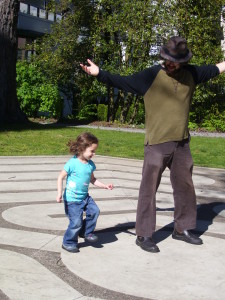“The twelve have been called both ‘disciples, mathetes, ‘learners’, and ‘apostles’, apostoloi, ‘sent-out ones’… Learning is done on the way; action and learning belong together.” Leith Fisher, But I Say to You p. 137.
Jesus’ twelve named friends are students on the road. And aren’t we all? Isn’t that a wonderful way to look at these lives we’ve been given? Sent-out and called to learn as we go.
I spent some time on the train this weekend, claiming some necessary time to get away and connect with a friend. On the way there, the train was a perfect place to sit and read and think. Quiet, sun-filled, peaceful. Alone, because the kids were at home with the Spouse, and I was enjoying a stretch of uninterrupted thinking time. I made it through several chapters of “But I Say to You” in one go. Almost maternally unimaginable.
But then, I got where I was going, put the books away and dug into the more social part of the weekend. I thought that I’d get my books back out again on Sunday on the train-ride home. There would ample time to look things over then – and to get my notes written up to post here before bedtime. Ha. The Sunday afternoon train was no sanctuary. Crowded. Noisy. Obnoxiously over-booked. The aisles were crammed with people, and, up top, the overhead shelves were precariously full. I could just about get my book open, but turning pages was awkward, and writing was completely out of the question. No space for quiet reflection for this learner on the road.
So, it’s Monday morning again, I’m writing at home, and looking over the notes I made and the dog-eared pages where I had wanted to make notes but didn’t. Matthew 13 is the section for this week that stands out the most for me. All those parables. All those snapshots of the Kingdom. There is an urgency here, almost as if Jesus was trying to fill his friends up with as many images and examples as possible that, in abundance the radical reality and nearness of God would be unmistakable. Despite the inconveniences of travel, and despite the crowds that push in so close that Jesus has to sit in a boat to teach, he shares story after story. The kingdom is like… the kingdom is like… the kingdom is like… There’s an ache there.
Last Friday, Lisa-Jo, who writes at The Gypsy Mama, wrote about ache. On Fridays, she suggests a theme and those who wish to step up to the challenge, commit five minutes to writing. Here’s how she describes it:
“Around here we write for five minutes flat on Fridays. We write because we love words and the relief it is to just write them without worrying if they’re just right or not. So we take five minutes on Friday and write like we used to finger paint. For joy in the process. No matter how messy the result.”
There’s an ache in the storytelling of Jesus – an ache for us that we might catch a glimpse of the Kingdom he is proclaiming, an ache that we might be filled with the things of God, an ache that we might know God, and that our knowledge of God will be so concrete that it feels like a place. An ache for what Christiana Peterson called “His ancient always home,” where all things come to peace and fulfilment and love.

Because Jesus carried this loving ache, he feeds his friend with stories of the kingdom. These stories feed the imagination as much as the loaves and the fish fill the bellies of the crowd. They are nourishing. And they are just as necessary.
Eugene Peterson wrote about the essential nature of the imagination like this:
“Imagination is the capacity to make connections between the visible and the invisible, between heaven and earth, between present and past, between present and future. For Christians, whose largest investment is in the invisible, the imagination is indispensable, for it is only by means of the imagination that we can see reality as a whole.” Eugene Peterson, Subversive Spirituality, p.131
I am finding that reading Matthew this Lent is stretching my own imagination. As I’m finding again how all bits I remember fit into each other, I am also finding a larger story of Jesus’ own learning on the road. There is so much happening, and so many questions as Jesus and the disciples work to bring healing and hope to all sorts of people. This week, we come to Matthew 16 and the Canaanite woman, and there is a huge bucket of wondering to do there – but perhaps we’ll leave that discussion for the comments section. Let me know what you think.
Here are the readings:
13. The Hard Road – Matthew ch 10
14. The Light Burden – Matthew ch 11
15. Up Against It – Matthew ch 12
16. More Than Meets to Eye – Matthew ch 13:1-52
17. No and Yes – Matthew ch 13:53-14:36
18: Old and New – Matthew ch 15



